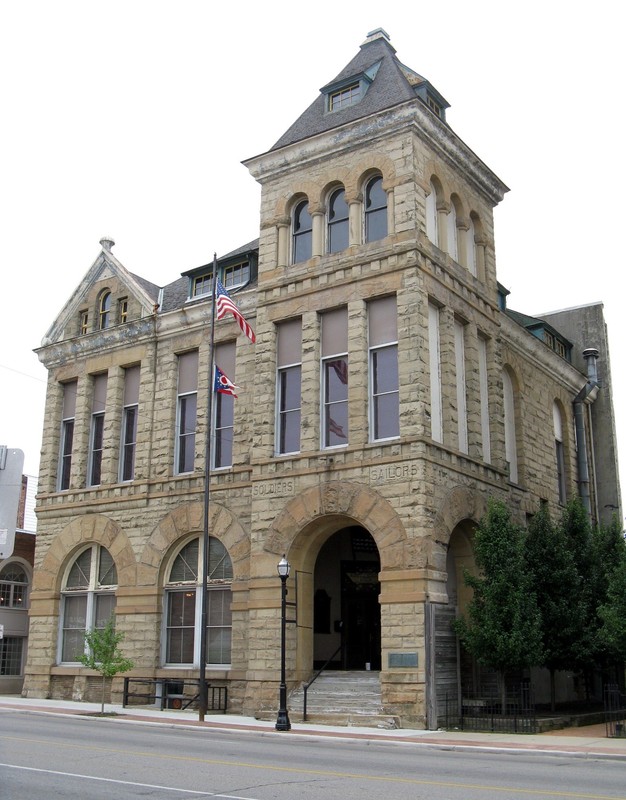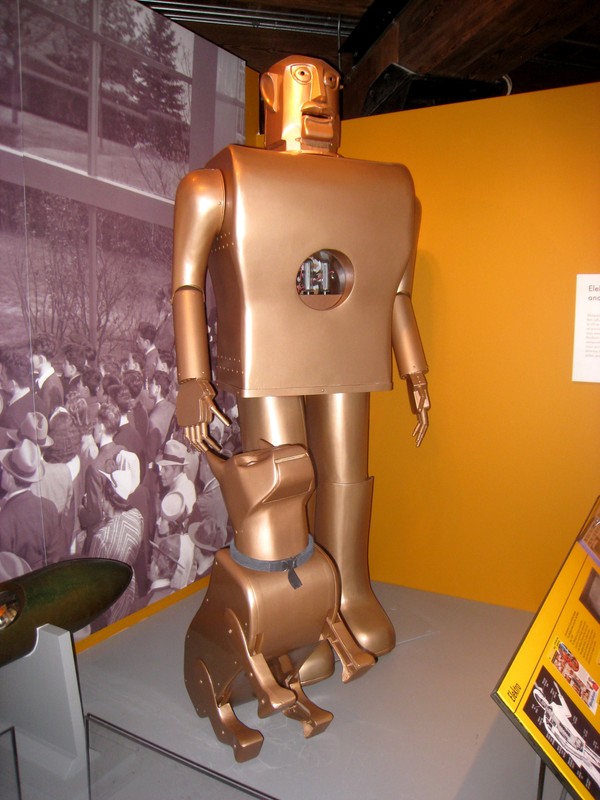The Mansfield Memorial Museum in the Soldiers and Sailors Memorial Building
Introduction
Text-to-speech Audio
Images
The Soldiers and Sailors Memorial Building, home of the Mansfield Memorial Museum

A replica of "Elektro the Moto-Man and his Little Dog Sparko" at the Senator John Heinz History Center in Pittsburgh. The original Elektro is housed in the Mansfield Memorial Museum.

Backstory and Context
Text-to-speech Audio
Over a dozen Civil War memorial halls were constructed throughout Ohio in the late 1800s. Serving as both monuments and useful public facilities, they were popular with communities throughout the state. Mansfield’s memorial hall was supported by a special act of the Ohio legislature and by issuing bonds. Oscar Cobb, a prominent Chicago architect known for his work on theaters, was chosen to design the structure. Built in the Richardsonian Romanesque style with a sandstone exterior, what is now known as the Soldiers and Sailors Memorial Building was begun in 1887 and dedicated on October 2nd, 1889. Originally, it housed the library on the first floor, meeting halls for the Grand Army of the Republic on the second floor, and a theater on the third floor.
An 1,100-seat auditorium, first known as the Library Hall and later as the Opera House, was constructed in 1889 adjacent to the Memorial Building to fund its counterpart’s public functions, which it did quite successfully. After it was completed, in 1892, Edward Wilkinson established the Mansfield Memorial Museum on the third floor of the Memorial Building. Wilkinson had been an artifact buyer for the Smithsonian Institution, Carnegie Natural History Museum, and the Peabody Field Museum, and had amassed an impressive personal collection, which he donated to his new Museum. The Museum was quite popular, receiving 65,000 visitors by 1900. (Mansfield’s population at the time was around 14,000.)
The library moved out to a new structure donated by Andrew Carnegie in 1908. The Opera House burnt to the ground in catastrophic fire that killed two people on the night of February 10th, 1929; however, the Memorial Building was barely damaged due to a strong fire wall separating the two structures. A new auditorium, an ornate art deco building that could seat 1,500 people, was designed by New York theater architect John Eberhard. It was christened the Madison Theater, and it was used until 1986, when it was demolished.
The Museum was closed by the fire marshal in 1955 but reopened to the public in 1999. Today, it features uniforms and memorabilia from every major American war; over a thousand models of military vehicles and aircraft; a diverse natural history collection, including medicinal plants, animals and insects from Ohio and Africa, and original trees planted by “Johnny Appleseed”; and artifacts from local history, especially local industries. This last collection includes “Elektro,” the famous robot built by Westinghouse at their Mansfield plant between 1937 and 1938 for the New York World’s Fair in 1939. Elektro was the premier example of a series of humanoid Westinghouse robots that began with “Herbert Televox,” the first humanoid robot, in 1928. (The Museum also has the surviving parts and a full-size model of Herbert Televox.) Elektro could walk, talk, count on his fingers, blow up balloons, and even smoke cigarettes, all by specially-coded voice commands. After the fair, he toured, appeared on television shows and B movies, and spent some time at an amusement park before disappearing. His pieces were slowly rediscovered, and Elektro was reassembled for display in the Museum.
Sources
Home, About Us, ELEKTRO, Military Exhibits, and Breweries and Bottlers, The Mansfield Memorial Museum. Accessed July 15th 2020. http://www.themansfieldmuseum.com/home.html.
Landmarks Of Mansfield: Soldiers And Sailors Memorial Building, 1812Blockhouse. May 28th 2018. Accessed July 15th 2020. https://1812blockhouse.com/history-tourism/landmarks-of-mansfield-soldiers-and-sailors-memorial-building/.
McQuillin, Steven. Soldiers and Sailors Memorial Building and Madison Theater, National Register of Historic Places Inventory/Nomination Form, Ohio State Historic Preservation Office. May 27th 1980. National Archives Catalog. Accessed July 15th 2020. https://s3.amazonaws.com/NARAprodstorage/lz/electronic-records/rg-079/NPS_OH/80003214.pdf.
Marsh, Allison. Elektro the Moto-Man Had the Biggest Brain at the 1939 World’s Fair, IEEE Spectrum. September 28th 2018. Accessed July 15th 2020. https://spectrum.ieee.org/tech-history/dawn-of-electronics/elektro-the-motoman-had-the-biggest-brain-at-the-1939-worlds-fair.
Whitmire, Lou. Own a piece of Mansfield history: Madison Theater marquee letters for sale, Mansfield News Journal. November 21st 2018. Accessed July 15th 2020. https://www.mansfieldnewsjournal.com/story/news/2018/11/21/own-piece-mansfield-history-madison-theater-marquee-letters-sale/2065264002/.
By Publichall on Wikimedia Commons (https://commons.wikimedia.org/wiki/File:Soldiers_%26_Sailors_Memorial_Bldg_-_Mansfield,_Ohio.jpg) - CC BY-SA 3.0 (https://creativecommons.org/licenses/by-sa/3.0/deed.en)
By Daderot on Wikimedia Commons (https://commons.wikimedia.org/wiki/File:Senator_John_Heinz_History_Center_-_IMG_7802.JPG) - Public Domain
